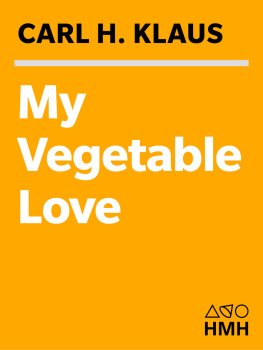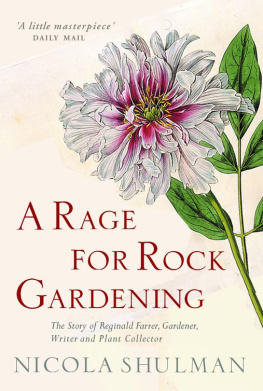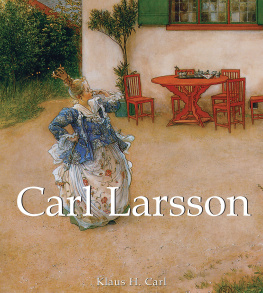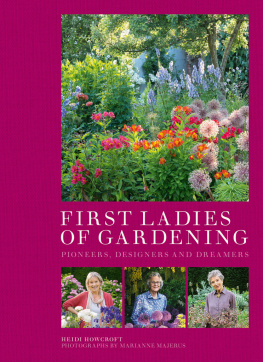Copyright 1996 by Carl H. Klaus
All rights reserved
For information about permission to reproduce selections from this book, write to Permissions, Houghton Mifflin Harcourt Publishing Company, 215 Park Avenue South, New York, New York 10003.
www.hmhco.com
The Library of Congress has cataloged the print edition as follows:
Klaus, Carl H.
My vegetable love : a journal of a growing season / Carl H. Klaus.
ISBN 0-395-78587-1
1. Vegetable gardenIowaIowa CityAnecdotes. 2. GardenersIowaIowa CityAnecdotes. 3. Klaus, Carl H. I. Title.
SB 320.7.18 K 58 1996 96-17836
635'.092dc20 CIP
e ISBN 978-0-544-34352-8
v1.0614
TO KATE
Acknowledgments
I am grateful to the University of Iowa for a research leave that gave me time to envision this journal and begin the work of turning my days into a daybook. Once under way, I was buoyed by the generosity of several people who took the time to read a few weeks or months or a draft of the entire season. For their thoughtful reactions and suggestions, Im grateful to Connie Brothers, Bill Bulger, Rebecca Childers, Paul Diehl, Trudy Dittmar, David Hamilton, Diane Horton, Dan Roche, Mary Swander, and Tom Simmons. My special thanks to Mary Hussmann for her careful reading of every draft; also to Natalie Bowen and Liz Duvall for their meticulous copy editing and to Clay Harper for his assistance with the title. For her singular guidance in shaping the journal and finding a good home for it, Im very grateful to my agent, Elizabeth Kaplan. For her sage advice in refining it and bringing it so attractively into print, I am very grateful to my editor, Frances Tenenbaum.
Most of all, I am indebted to Kate Franks for keeping me accurate and grammatical every day from March through November, and for putting up with this daily intrusion in her life. Without her sufferance of itand her supportI could not have written this book.
My vegetable love should grow
Vaster than empires and more slow...
But at my back I always hear
Times winged chariot hurrying near...
Andrew Marvell, To His Coy Mistress
Introduction
Its high summer, and Im out in the yard, gazing at the back vegetable bed, the sun-filled site of tomatoes, peppers, and eggplants. Gazing because its the day Ive been waiting for ever since the first hard frost of last yearthe day when all these warm-weather plants are pumping out ripe fruit again, all at the same time. Tomato vines along the back row more than five feet up the seven-foot poles, their red and green fruit entwined with leaves from top to bottom, like della Robbia garlands in the garden. Three-foot-tall cubanelle and Italian pepper plants along the next row, branching out like fruit treestropical fruit treesbullhorn peppers dangling from their branches. An eggplant at each end of the row, their purple-veined leaves and long purple fruit framing the yellow-green, dark green, and red peppers. Bell pepper plants in front, branches beginning to bend under the weight of their fruit. Cherry tomato plants at each end of the row in large clay pots. A monument to Mediterranean cooking.
Which reminds me that Im not just gazing. Im harvesting things for the first all-fresh ratatouille of the summer. Vegetable stew, according to my wife Kate. Remember, were in Iowa, not France. And besides, I dont cook it to death like the French. Actually, she cooks it like the Italians, quickly, so the vegetables retain more of their distinct colors, textures, and tastes. Which reminds me that on the way in Im supposed to stop at the big vegetable garden for a green zucchini, a yellow pattypan, and a couple of onions. Then at the herb bed by the gazebo for some basil, parsley, and thyme. By the time I reach the back porch off the kitchen, my oak basket will be as fit for a still life as a stew.
A strange moment. So filled like the basket with heat and sunlight and color that I think it could easily last for months on end. Tomatoes and peppers and eggplants galore. Red and green and purple and more. And all the others toobeans, chard, cucumbers, okra, pattypans, zucchini. All the stuff for gazpacho, gumbo, baba ghanouj, and God knows what else. Until I suddenly realize its just about time to seed up some flats of lettuce to go in front of the peppers a month or so from now. Fall lettuce exactly where I planted the spring greens back in mid-March. My head is spinning, fast forward and reverse. A month from now, the first cool nights of September. Two months from now, the first hard frost. And not even my row covers can keep those warm-weather vegetables warm enough to keep going for more than three months at most. Three months of high-summer harvest for nine or ten months of planning, seeding, transplanting, and tending. Seven months of harvest for all the vegetables, from May to December.
So many days, so many hours devoted to bringing on so many vegetables all at once that my basket runneth over, like a horn of plenty, with more than we can possibly eat fresh or can or freeze or pickle or preserve. Why is it, I wonder, that I go through all the hassle, when Kate and I can easily walk a few blocks to the nearest supermarket, or a few blocks more to the local co-op, and get all the fresh produce we need, as we do during most of the winter and early spring? Whenever I ask that question, as I do several times each gardening season, I always come up with the same answers. The freshness. The taste. The variety. The exercise. The fresh air. The challenge. The environment. The past. All the present virtues, all valid, but none of which convey what I go through in the garden or why I go through it day after day, week after week, month after month, year after year.
So, in an effort to make sense of it, I decided one day in mid-December of 1994 that Id take stock of my garden and my gardening every day during the growing season of 1995. And every day write a brief report of my activities. From the first outdoor planting in early spring to the last harvest in very late fall, when the gardening catalogues for 1996 are beginning to arrive and winter dreamtime is about to begin. A vegetable gardeners year. But I didnt want to confine myself so narrowly to the vegetable garden that I ignored all the conditions that influence a gardener and his plants. So my reports regularly take stock of the weather and the seasons and everything else in my immediate world, which includes Kate, our Welsh terrier Pip, our foundling cat Phoebe, and the other gardens, trees, and shrubs weve been tending on our three-quarter-acre lot for the past twenty-five years. Especially Kates sixty-foot ornamental flower border, centered near the back of the yard, changing like a vivid backdrop with the changing seasons. Also the various wild animals that live on our land or that pass through it. Crows, deer, groundhogs, moles, possums, rabbits, raccoons, squirrels, and sparrowsall the creatures that trouble the heart of an ardent vegetable gardener. Also from time to time our neighbors, our neighborhood, the university where I teach, as well as other places and people I encounter or think about on my walks in the City of Iowa City, where I live.
In the garden of Eden, where Adam and Eve lived, the sun, I assume, shone every day, except for brief periods of refreshing and replenishing showers. The seasons did not exist. Temperatures were continuously moderateneither so cold nor so hot as to be even slightly uncomfortable. The weather, you might say, was ideal. The only biblical reference to it describes the Lord God walking in the garden in the cool of the day, shortly after the serpent had tempted Eve, and Eve had tempted Adam to eat of the forbidden fruit. Change, on the other hand, is at the heart of my gardenso much so that if it didnt change, it wouldnt be an actual garden but some mythic place, like the garden of Eden, where there were no seasons or seasonal changes to be observed.
Next page









